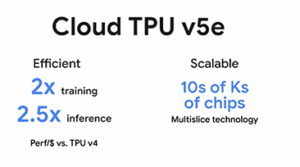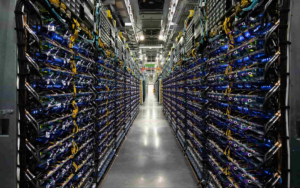
The dominance of Nvidia GPUs has corporations scrambling to seek out non-GPU alternate options, and one other mainstream choice has emerged with Google’s TPU v5e AI chip.
The TPU v5e can also be Google’s first AI chip being mainstreamed with a collection of software program and instruments for large-scale orchestration of AI workloads in digital environments. The AI chip is now accessible in preview to Google Cloud prospects.
The brand new AI chip succeeds the previous-generation TPUv4, which was used to coach the newer PaLM and PaLM 2 massive language fashions utilized in Google search, mapping, and on-line productiveness purposes.
Google has usually in contrast its TPUs to Nvidia’s GPUs however was cautious with the TPU v5e announcement. Google harassed it was centered on providing a wide range of AI chips to its prospects, with Nvidia’s H100 GPUs within the A3 supercomputer and TPU v5e for inferencing and coaching.
The Cloud TPU v5e can also be the primary Google AI chip accessible exterior the US. The TPUv4 was accessible solely in North America. The TPU v5e computer systems shall be put in within the Netherlands for the EMEA (Europe, Center East, and Africa) markets and in Singapore for the Asia-Pacific markets.
The origins of TPU v5 have been mired in controversy. Researchers at Google informally introduced TPU-v5 in June 2021 and, in a paper, stated AI was used to design the chip. Google claimed that AI brokers helped floor-plan the chip in beneath six hours quicker than human specialists. There have been inside debates on the claims made within the paper, and Google fired one researcher forward of the paper’s look in Nature journal.
Tutorial researchers additionally referred to as out Google’s claims and criticized the corporate for not opening it up for public scrutiny. A researcher, Andrew B. Kahng, from the College of California, San Diego, later reverse-engineered Google’s chip-design strategies and located that human chip designers and automatic instruments have been typically quicker than Google’s AI-only approach.
Google has maintained a silence on that controversy however has moved forward and is constructing an AI empire round TPUs. The corporate’s large-language fashions are optimized to run on TPUs, and the brand new chips are crucial to Google’s information facilities as the corporate infuses AI options throughout product strains.
The efficiency numbers level to the TPU v5e being tailored for inferencing as an alternative of coaching. The chip provides a peak efficiency of 393 teraflops of INT8 efficiency per chip, which is best than 275 petaflops on TPU v4.

The brand new Google TPU v5e is extra environment friendly and extra scalable than v4, Google says.
However the TPU v5e scores poorly on BF16 efficiency, with its 197 teraflops falling wanting the 275 teraflops on the TPU v4.
However TPU v5e might outperform the TPU v4 when conjoined in clusters. The TPU v4 could possibly be configured in clusters of 4,096 chips, however TPU v5e can broaden to a whole bunch or hundreds extra configurations and deal with even bigger coaching and inferencing fashions.
Google Cloud executives Amin Vahdat and Mark Lohmeyer, in a weblog entry stated “the scale of the most important jobs at a most slice measurement of three,072 chips for TPU v4,” and never 4,096 chips, as beforehand claimed. However with TPU v5e, the corporate has launched a know-how referred to as “Multislice,” which may community a whole bunch of hundreds extra AI chips collectively in a cluster.
Multislice “permits customers to simply scale AI fashions past the boundaries of bodily TPU pods — as much as tens of hundreds of Cloud TPU v5e or TPU v4 chips,” Google executives stated.
Google has additionally finetuned digital machines for TPU v5e so chips can course of a number of digital machines concurrently. Google introduced the supply of the Kubernetes service for Cloud TPU v5e and v4, which can assist orchestrate AI workloads throughout the TPUs.
Google stated the most important configuration might deploy 64 digital machines throughout 256 TPU v5e clusters. The TPUs work with machine-learning frameworks that embody Pytorch, JAX, and TensorFlow.
“TPU v5e can also be extremely versatile, supporting eight completely different digital machine configurations, starting from one chip to greater than 250 chips inside a single slice. This function permits prospects to decide on the suitable configurations to serve a variety of LLM and gen AI mannequin sizes,” Google execs wrote.
Every TPU v5e chip has 4 matrix multiplication models, a vector, and a scalar processing unit, that are all related to HBM2 reminiscence.
Google’s information facilities have a swap-in, swap-out high-bandwidth infrastructure with optical switches that hyperlink up AI chips and clusters. The optical interconnect permits every rack to function independently and interconnected on the fly, and know-how permits Google to shortly reconfigure the community topology relying on the appliance.
Google supplied fascinating efficiency comparisons to TPU v4 based mostly on price. The benchmark is a sensible assumption of the price of coaching and the scale of a mannequin. Microsoft and Google are investing billions of their information heart infrastructure so corporations can prepare and deploy bigger AI fashions
 For each greenback, the TPU v5e is as much as two instances quicker in coaching and a couple of.5 instances inferencing instances. The TPU v5e is priced at $1.2 per chip hour, whereas the TPU v4 is about $3.2 per hour.
For each greenback, the TPU v5e is as much as two instances quicker in coaching and a couple of.5 instances inferencing instances. The TPU v5e is priced at $1.2 per chip hour, whereas the TPU v4 is about $3.2 per hour.
“At lower than half the price of TPU v4, TPU v5e makes it attainable for extra organizations to coach and deploy bigger, extra complicated AI fashions,” the Google executives stated within the weblog.
Google has shared the TPU v5e configurations on its web site, that are damaged up into coaching and inference pages.
The coaching mannequin is for “transformer, text-to-image, and Convolutional Neural Community (CNN) coaching, finetuning, and serving,” Google stated on its web site.
Google individually introduced that the A3 supercomputer, which has as much as 26,000 Nvidia H100 GPUs, shall be usually accessible subsequent month. The A3 is designed for corporations working with huge large-language fashions, together with monetary, pharmaceutical, and engineering companies.
Google’s TPU compute infrastructure was talked about as an ace up its sleeve by analysis agency SemiAnalysis in a publish on August 27. The publish largely addressed “GPU Poors,” or corporations that shouldn’t have prepared entry to GPUs which can be in heavy demand. The publish elicited an unprovoked response from Sam Altman, the CEO of OpenAI, who wrote, “Unbelievable google received that SemiAnalysis man to publish their inside advertising and marketing/recruiting chart lol.” The alternate was largely pleasant banter with no severe punches thrown.
OpenAI’s infrastructure is swimming in GPUs partly because of Microsoft’s AI infrastructure, which has doubled down on graphics chips from Nvidia. Cloud suppliers cost a major premium to entry Nvidia’s A100 and H100 GPUs. However in contrast to Microsoft, Google is just not placing its eggs in a single basket, and including TPUs permits a variety of AI choices at a number of worth factors.
Amazon AWS has additionally built-in its homegrown Trainium and Inferentia chips for coaching and inferencing. Intel has a $1 billion pipeline of orders for its AI chips, which embody Gaudi2 and Gaudi3 chips.
This text first appeared on sister website HPCwire.
Associated
#Google #TPU #v5e #Chip #Debuts #Controversial #Origins


